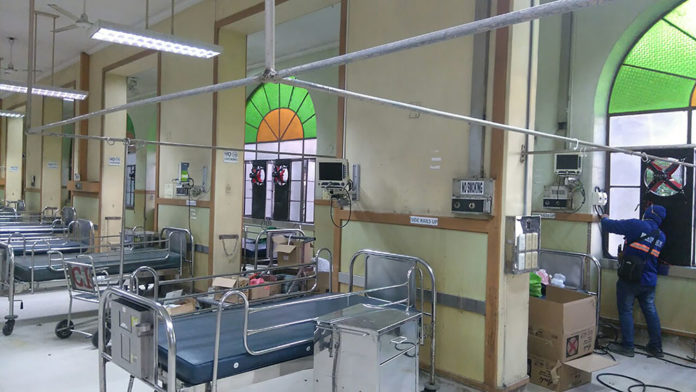DPWH eyes more buildings for Covid-19 isolation sites
By Lorenz S. Marasigan & Butch Fernandez

This is the PGH ward retrofitted to function as one of three Covid-19 referral centers. CONTRIBUTED PHOTO
WITH hospitals and health-care facilities struggling to accommodate more persons under monitoring and investigation (PUIs and PUMs), the Department of Public Works and Highways (DPWH) will soon convert public buildings and open spaces into makeshift health facilities and isolation sites to address the hospital shortage amid the spreading novel coronavirus disease (Covid-19).
Public Works Secretary Mark A. Villar said at the weekend the proposal involves the conversion of the Philippine International Convention Center (PICC), World Trade Center (WTC), Rizal Memorial Coliseum, and Philippine Institute of Sports Multipurpose (Philsport) Arena into isolation facilities for almost 3,000 patients.
Some quarters, notably Sen. Nancy Binay, had earlier called for the conversion of sites like the Rizal Memorial into quarantine areas, noting that a government guarantee of suitable isolation sites is the best motivation for people to strictly follow quarantine protocols.
The open spaces of the WTC, Philsport Area, Rizal Coliseum, Quezon Memorial Circle, University of the Philippines-Diliman Campus, Veterans Memorial Medical Center, and the Cultural Center of the Philippines (CCP) may also be used for prototype tents, the DPWH said.
A total of 747 tents may be deployed in such areas, which can accommodate up to 7,470 patients.
“In coordination with the Department of Health, the DPWH…has drawn up the conversion of wide open spaces into isolation sites, where prototype tents can be installed. Tents will have proper ventilation and appurtenances, and toilets and bathrooms,” Villar said.
The DPWH is eyeing the old Casino Filipino building near the Ninoy Aquino International Airport (Naia) Terminal 1 as an isolation facility.
It also sent a team of construction workers and electricians to fix four identified spaces at the Philippine General Hospital that will be used to accommodate Covid-19 patients starting this week.
Referral center ready
Private construction group D.M. Consunji Inc. (DMCI) completed last week the retrofitting of two wards inside the University of the Philippines-PGH into a Covid-19 referral center. The medical facility, to house confirmed Covid-19 patients and high-risk PUIs, was formally turned over to UP-PGH on Thursday.
To fast-track the construction process and control the exposure of its workers, DMCI prefabricated offsite the partition walls, exhaust frames and stairs needed to isolate the Covid-19 facility from the rest of the hospital. A dedicated team of DMCI workers handled the installation of the prefabricated materials.
The UP-PGH Covid-19 referral center is one of three government-designated coronavirus referral hospitals in the National Capital Region. It has “negative pressure” rooms that suck in contaminated air, ventilators and separate access points for patients and medical staff.
DMCI workers rushed to complete the project in five days in response to the PGH’s tight deadline. Earlier, UP-PGH Director Dr. Gerardo “Gap” Legaspi said they needed a week to fully prepare the hospital for its role as a coronavirus referral center.
“Much of the credit goes to our workers who rose to the challenge of delivering this project on time and in accordance with social distancing and sanitation protocols. We also commend the management of UP-PGH, Architect Dan Lichauco and Bloomberry Foundation for supporting our workers throughout the construction work,” said DMCI President and CEO Jorge A. Consunji.
Sherwin: Isolation tents
Earlier, the DPWH allowed the use of 110 evacuation centers as health-care facilities and emergency operations centers. So far, 29 facilities are now being used by different groups in various regions in the country.
On Sunday, local government officials were asked to set up makeshift mini-hospitals and “isolation tents” where patients with mild symptoms of Covid-19 can be quickly isolated to avert spreading the virus in their localities.
Sen. Sherwin Gatchalian proposed the alternative option over the weekend, citing the “increasing number of Filipinos contracting the deadly coronavirus.”
He said local government units (LGUs) on their own can promptly put up the temporary quarters “in wide, well-ventilated, and covered spaces like gymnasia, where tents can serve as isolation areas for persons under investigation and those who are recovering from the disease.”
Schools, dormitories and hotels can also be utilized as isolation areas, he said, airing concern that hospitals are “now overwhelmed with the spike in Covid-19 cases straining medical facilities and triggering some to turn away patients.”
He noted that at least three patients, tested positive in Quezon City, were sent home as “the facilities they were supposed to be confined in did not have enough space.”
Gatchalian recalled that Wuhan, China, “former epicenter” of the coronavirus pandemic, had 16 makeshift hospitals treating 13,000 patients. These facilities eventually closed as Wuhan’s cases plunged. South Korea solved its bed shortage by reserving hospital beds for the acutely ill while putting less sick patients in dormitories.
He cited Valenzuela’s centralized isolation facilities at the Balai Banyuhay and Valenzuela Astrodome’s modular tents and military cots for patient use, apart from Balai Banyuhay, the city’s unused drug rehabilitation and treatment facility, with 100 beds.
Source: Business Mirror
